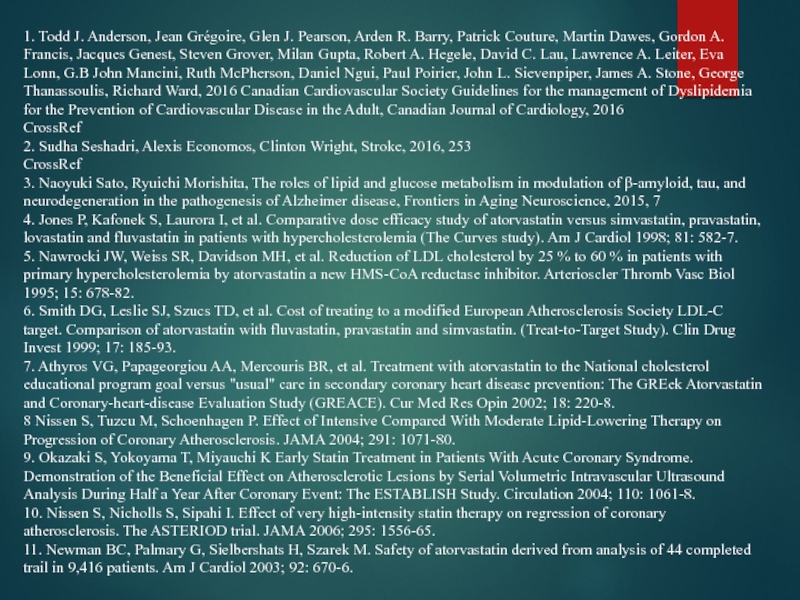Слайд 12RESULTS:
The matched-pair cohort included 5,480 patients (mean age 67 years; 44%
women) treated/nontreated with statins. The 10-year coronary heart disease risk was low (median: 6.9%). Median follow-up was 3.6 years. Incidence of MACE was 19.7 and 24.7 events per 1,000 person-years in statin new-users and nonusers, respectively. Total mortality rates also differed: 24.8 versus 30.3 per 1,000 person-years, respectively. Hazards ratios were 0.80 for MACE and 0.81 for overall mortality. The 1-year number needed to treat was 200 for MACE and 239 for all-cause mortality.
CONCLUSIONS:
Statin therapy was associated with a reduction in MACE and all-cause mortality among participants without clinical CVD but with asymptomatic peripheral arterial disease, regardless of its low CVD risk. The absolute reduction was comparable to that achieved in secondary prevention.
Copyright © 2016 American College of Cardiology Foundation. Published by Elsevier Inc. All rights reserved.
Слайд 161. Todd J. Anderson, Jean Grégoire, Glen J. Pearson, Arden R.
Barry, Patrick Couture, Martin Dawes, Gordon A. Francis, Jacques Genest, Steven Grover, Milan Gupta, Robert A. Hegele, David C. Lau, Lawrence A. Leiter, Eva Lonn, G.B John Mancini, Ruth McPherson, Daniel Ngui, Paul Poirier, John L. Sievenpiper, James A. Stone, George Thanassoulis, Richard Ward, 2016 Canadian Cardiovascular Society Guidelines for the management of Dyslipidemia for the Prevention of Cardiovascular Disease in the Adult, Canadian Journal of Cardiology, 2016
CrossRef
2. Sudha Seshadri, Alexis Economos, Clinton Wright, Stroke, 2016, 253
CrossRef
3. Naoyuki Sato, Ryuichi Morishita, The roles of lipid and glucose metabolism in modulation of β-amyloid, tau, and neurodegeneration in the pathogenesis of Alzheimer disease, Frontiers in Aging Neuroscience, 2015, 7
4. Jones P, Kafonek S, Laurora I, et al. Comparative dose efficacy study of atorvastatin versus simvastatin, pravastatin, lovastatin and fluvastatin in patients with hypercholesterolemia (The Curves study). Am J Cardiol 1998; 81: 582-7.
5. Nawrocki JW, Weiss SR, Davidson MH, et al. Reduction of LDL cholesterol by 25 % to 60 % in patients with primary hypercholesterolemia by atorvastatin a new HMS-CoA reductase inhibitor. Arterioscler Thromb Vasc Biol 1995; 15: 678-82.
6. Smith DG, Leslie SJ, Szucs TD, et al. Cost of treating to a modified European Atherosclerosis Society LDL-C target. Comparison of atorvastatin with fluvastatin, pravastatin and simvastatin. (Treat-to-Target Study). Clin Drug Invest 1999; 17: 185-93.
7. Athyros VG, Papageorgiou AA, Mercouris BR, et al. Treatment with atorvastatin to the National cholesterol educational program goal versus "usual" care in secondary coronary heart disease prevention: The GREek Atorvastatin and Coronary-heart-disease Evaluation Study (GREACE). Cur Med Res Opin 2002; 18: 220-8.
8 Nissen S, Tuzcu M, Schoenhagen P. Effect of Intensive Compared With Moderate Lipid-Lowering Therapy on Progression of Coronary Atherosclerosis. JAMA 2004; 291: 1071-80.
9. Okazaki S, Yokoyama T, Miyauchi K Early Statin Treatment in Patients With Acute Coronary Syndrome. Demonstration of the Beneficial Effect on Atherosclerotic Lesions by Serial Volumetric Intravascular Ultrasound Analysis During Half a Year After Coronary Event: The ESTABLISH Study. Circulation 2004; 110: 1061-8.
10. Nissen S, Nicholls S, Sipahi I. Effect of very high-intensity statin therapy on regression of coronary atherosclerosis. The ASTERIOD trial. JAMA 2006; 295: 1556-65.
11. Newman BC, Palmary G, Sielbershats H, Szarek M. Safety of atorvastatin derived from analysis of 44 completed trail in 9,416 patients. Am J Cardiol 2003; 92: 670-6.
